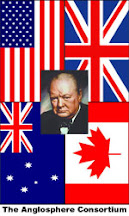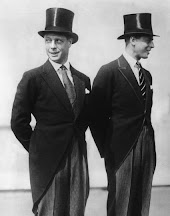Year of the Smoking Pipe
HOW MANY POOR SOULS made yet another new year's resolution promising themselves they're going to quit smoking? Hah! As a social smoker (and occasional drinker), I intend to carry on handsomely, thank you very much. With a few precautionary safeguards to protect the family from the pungent fumes, and a smoking jacket to keep the ashes and embers off my clothing, my resolution in 2008 is to take up pipe smoking - a promise I intend to keep! Do read on - the tobacco pipe is good for the soul, and a blessing to all who are near.
TOBACCO AND THE SOUL
by Michael P. Foley
Copyright (c) 2006-2008 First Things (April 1997).
The current brouhaha over smoking has made everyone painfully aware of tobacco’s effects on the body, but it has also obscured a more profound reason for smoking’s popularity: its relation to the soul. As the heyday of smoking passes into the ashheap of history, it is meet that we reflect on this connection.
The soul, of course, is a complex thing. Long ago Plato suggested that we consider it as divided into three parts—the appetitive, spirited, and rational—that correspond to the three basic kinds of human desires: the desire to satisfy physical appetites, the desire for recognition, and the desire for truth. Once this tripartite division is recalled, tobacco’s relation to the soul becomes clear: the three prevalent types of smoking tobacco—cigarettes, cigars, and pipes—correspond to the three parts of the soul.
Cigarettes correspond to the appetitive part of the soul, a fact that explains their association with both food and sex. The connection with the latter is particularly obvious: think of the proverbial postcoital cigarette, or of the ubiquity of cigarettes at singles bars. People with strong physical desires demand instant gratification, and they try to make what they desire as much a part of their own bodies as possible: hunger demands eating, thirst drinking, and lust making the body of one’s lover a part of one’s own. So too with cigarettes. A cigarette is inhaled: it must be fully and internally consumed in order to give pleasure. And a cigarette, with its quick buzz, is also instant gratification. Even the cigarette’s notorious connection to death ties it into appetites: both are indifferent to health in their quest for satisfaction, and both, when they reach addictive levels, become hostile to it.
Cigars, on the other hand, correspond to the spirited part of the soul. This explains their traditional popularity among men seeking honor or reputation—politicians, executives, etc. The reason for this correspondence can be found in the similarity between cigars and ambition. A cigar is visually impressive: with its large size and great billows of smoke, it often leaves a greater impact on the spectator than on the smoker. Further, a cigar is phallic—not with regard to male lust, but to male power. “Testis” in Latin means “witness”: the phallic status of the cigar is meant to bear public witness to the smoker’s prominence, his virility. The fact that a cigar is not inhaled reflects this external focus.
Ambition also has these traits: it too is more external than internal. Unlike physical desires, which are satisfied simply by consumption, ambition requires the consensus of others. The honor-seeker, for example, has to be honored by as many people as possible in order to be satisfied.
Finally, the pipe corresponds to the rational part of the soul, which explains why we tend to picture wise figures smoking pipes: the Oxford don surrounded by his great books, or Sherlock Holmes, who, in Doyle’s original stories, actually smoked other sorts of tobacco as well, yet is almost always portrayed with a pipe. Unlike cigars and cigarettes, a pipe endures. Similarly, the questions of the philosopher far outlast the passing concerns of physical desires on the one hand and human ambitions on the other. Further, while the cigar is entirely masculine, the pipe has both masculine and feminine elements (the stem and the bowl). This corresponds to the philosopher’s activity, which is both masculine and feminine: masculine in its pursuit of Lady Truth, feminine in its reception of anything that she discloses. Finally, the effect that the pipe has on others is analogous to the effect of philosophizing: the sweet fragrance of a pipe, like good philosophy, is a blessing to all who are near.
It is fitting that all three kinds of smoking tobacco involve the use of fire, for each relates to the soul’s responsiveness to reason, and fire, at least from the days of Prometheus, is especially emblematic of reason. But there are also nonhuman parts to the human soul. The growth of our hair and fingernails, for example, is due to the soul’s activity, yet is not responsive to rational instruction.
The use of tobacco that does not involve fire, therefore, somehow corresponds to these nonhuman—or more accurately, subhuman—parts of the soul. Chewing tobacco, for example, is a quintessentially subhuman activity. It is the rumination of bovine men. Or perhaps we should say it is camel-like, for camels not only chew, but spit as well. In either case, the point is clear: chewing tobacco is a sub-rational activity, which is why we usually associate it with men of limited acumen.
Snuff, too, would fall into this category, but with some minor differences. First, because it is not so disgusting, it would not have the same negative connotations as “chew.” (Activities can be sub-rational without being bad.) Second, snuff taken through the nose would fall under a different category. Everything else we have seen involves the mouth, and this is only natural, for the mouth was made to receive things into itself. But to sniff something up one’s nose . . . this is unnatural.
A question remains, however, about smoking non-tobacco. One candidate immediately comes to mind because it, like tobacco, is a natural leaf. Marijuana is also noteworthy because it is used in the same ways as smoking tobacco.
The key to the difference between the two is how each one affects the smoker. Tobacco—whether in a cigarette, cigar, or a pipe—leads to conversation, loosening the tongue just enough to incline it towards speaking, but not enough to disconnect it from the brain. Marijuana, on the other hand, does not keep this balance, loosening the tongue only to have it reel away from rational thought. It does not truly facilitate conversation, drawing the smoker into himself (not outwards, as does all good conversation) and dumbing-down any speech that is uttered. Thus the appearance of conversation can be created, but it is usually only that—an appearance. Marijuana is therefore a charlatan-weed, an impostor that apes its distant relative tobacco in a shallow and perverse way.
The uses of marijuana are twisted imitations of the uses of tobacco. Joints perversely imitate cigarettes in both their appearance and in their users’ claim to be erotic. But while the claim is one thing, the reality is another. Eros requires both a healthy tension and a sense of discrimination in order to be truly human. Marijuana, however, eliminates both. Think of the counterculture of the 1960s, which, in preaching sexual liberation, actually destroyed the human part of our sexuality by robbing sex of any sense of mystery, standards, or fidelity. Where once sex was a magical moment between eternally committed lovers, it was now purely animalistic, something that had no more meaning than any other bodily function. The pot-smoker fancies himself an erotic man, but ends up being an unerotic animal.
Similarly, the hash pipe is a perverse imitation of the tobacco pipe. The pot-smoker often fancies himself an intellectual: he gets high and thinks “deep thoughts” (again bringing the 1960s to mind). But the appearance is one thing, the reality another. Just as the wisdom of the 1960s student turns out to be sophomoric, so too do the deep thoughts of the pot-smoker end up being moronic.
And yes, there is even a marijuana counterpart to the cigar. In the early 1990s the inner cities gave birth to a new practice called “blunting,” in which cheap cigars are gutted and stuffed with marijuana. It is fitting that this practice originated in the same place where gangs come from. An inner-city gang seems supremely concerned with honor and courage: its elaborate codes would suggest as much. But seeming is one thing, being another. The gang-member fancies himself honorable, but is in reality a thug. Just as the cigar is the counterpart to the real virtues of honor and courage, the marijuana-blunt is the counterpart to the fake virtues of gang-honor and gang-courage.
As every student of Plato knows, if something has a relation to the soul it has a relation to the city. Thus if our theory is anything more than the smoke it purports to explain, it can be used to analyze political phenomena. For example, in recent years we have witnessed a concerted effort to sterilize our erotic attachments, to sap them of their danger but also of their vigor. The flat, unerotic words we now use for these attachments confirm this. Instead of “lover” and “beloved,” we now have “significant other” and, even worse, “partner” (a term which lends to the affairs of the heart all the excitement of filling out a tax form). Given this environment, it is no wonder that our most vigorous moral war waged today is against cigarette-smoking. Nor is it any wonder that this war’s only rival in intensity is the one in favor of “safe sex,” for condoms sterilize sex not only literally but figuratively as well.
Further, the relation between cigars and spiritedness may explain why cigars are now for the first time gaining a significant number of female disciples. For as women continue to enter the traditionally male world of competition, many are beating men at their own game by using the same tactics of gaining power. And with the tactics have come the symbols.
Most significantly, however, the relative rarity of pipe-smoking in America is a telling sign of its current intellectual crisis. If the pipe epitomizes the intellectual way of life, then is it any surprise that it cannot be found where schools substitute politically correct ideology for real philosophy, or where the intelligentsia, instead of engaging in serious thought, pander to the latest activist fads? Is it any surprise that America’s most famous pipe-smoker in the last thirty years has been Hugh Hefner, pajama prophet of the trite philosophy of hedonism? No, the age of the pipe-smoker is as far from us as the day when philosophers will be kings and kings will philosophize, a sad reality to which the thick blue haze of non-pipe smoke is only too ready to attest.
It should also be no surprise in this pipeless age that the ferocious battle over tobacco has missed the real point about its addictive power. Tobacco holds sway over the soul as much as it does the body. The qualities it takes in its various forms make it a near irresistible complement to the particular desire dominant in an individual’s soul. How we react to these forms says as much about our attitude toward those desires as it does toward the weed itself.
 Vice-Regal Saint:
Vice-Regal Saint: 








































.gif)

.gif)















































































































10 comments:
Very interesting blog and post about smoking.
I recently purchased a pipe myself but I have yet to test it out. I want to finish creating my "study" first.
Please update us on your experience and recommendations.
I have smoked cigars for years but have recently slowed down to the point of not having had one in many months. Two reason, firstly my wife and secondly cost - they are so damn expensive and with the PC crowd pushing the taxes up and up I just can't keep up.
I've always been tempted to smoke cigars or a pipe. While I can appreciate the smoke produced by both, I find cigarette smoking repugnant, oddly enough.
Unfortunately I have asthma and choking to death on ones cigar smoke is rather lacking in dignitas, I feel.
Her Majesty has been known to enjoy an occasional puff. I'm not sure how true that is anymore, however.
As a regular pipe-smoker I commend you on this most excellent resolution!
I should pass along a small anecdote that you will, doubtless, find amusing.
"Paul Johnson, writing in the Spectator (11 August) said…..” Ronnie Knox (Msgr. Ronald Knox), on coming into a strange room would sniff and say ‘ This room smells suspiciously of never having been smoked in.’ He thought a smokeless room might carry a curse. ‘the Devil lives in Hell but he never smokes.’ Writing in the same piece about his schooldays Paul Johnson says, " a priest told me ‘Tobacco is essential to a celibate priesthood.'"
I'm afraid I am with their Majesties James I and Charles I on this issue ...
Wow... What a 'thumper' of a post.
Interesting how in these times of tobacco persecution, that the old forms of tobacco usage are becoming popular again.
Snuff Store was recently asked to provide a sample for a popular 'music magazine'... They wanted to give their readers tobacco alternatives to smoking outside in the freezing cold to receive a nicotine hit!
It was with a sad heart that I told the reporter that I couldn't give away snuff 'samples', as I was governed by the same strict legislation covers giving away cigarettes / cigar freebies.
Fortunately, the reporter saw the funny side and happily purchased some samples to try for her article.
Snuffing tobacco is the oldest form of tobacco usage and the one seen and reported on by the 'discoverers' of the new world, when they observed native South Americans snorting a 'fine powder' through a pipe.
Users hail from all walks of professional life - from Judges, Clergy and Drs, all the way down to those of us fed up with not being allowed to smoke in pubs and clubs over a pint.
Good luck with the pipe for 2008.
Just so we are all clear about snuff; it is different in Australia and the UK from the USA. In Australia and The UK it means a dry powdered tobacco that is taken up the nose, whereas in the USA it is a type of chewing tobacco that is like a tea bag with powdered tobacco in it.
By the way snuff has now been made illegal to sell in Australia.
pipes are so good check this website about them: http://www.water-bongs-glass-pipes.com/
Post a Comment